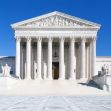On Wednesday, December 2, 2020, the Supreme Court of the United States (SCOTUS) engaged in a teleconference hearing to untangle the aftermath of a ruling they made last April in Ramos v. Louisiana. In that ruling, SCOTUS determined that federal and state court juries are required to be unanimous to convict a defendant of a serious crime. This decision struck down a provision of the Louisiana Constitution that had previously allowed convictions if only 10 of 12 jurors agreed. Justice Neil Gorsuch, who wrote the April decision, said the provision allowing a nonunanimous jury to convict was a relic of white supremacy. The teleconference focused on determining how those convicted under the prior system would be treated.
The Ramos decision, which applies only to defendants without final convictions, spurred discussion about whether the decision should apply to inmates who have exhausted their appeals. The primary question during the teleconference, though, was whether the Ramos decision was so enmeshed with constitutional rights that it must be applied retroactively, even if the result of that application is that thousands of convictions may now be in jeopardy. The discussion included questions about the origin and application of constitutional rights.
A 1989 case, Teague v. Lane, said that if the court is enforcing an old rule, it applies to prior cases. A new rule will only apply to old cases if it involves “bedrock” principles — those principles necessary to accomplish fair and accurate trials. This exception made for new “watershed rules” had not been used to this point.
The December hearing came in Edwards v. Vannoy, a case dealing with a Louisiana rape conviction. Chief Justice John Roberts told Andre Belanger, Thedrick Edwards’s attorney, “You have something of a burden establishing that the unanimous jury is necessary to avoid an impermissibly large risk of an inaccurate conviction.” Justice Elena Kagan said, “Ramos says that if you haven’t been convicted by a unanimous jury, you really haven’t been convicted at all. And so how could it be that a rule like that does not have retroactive effect?”
Edwards was 19 when he was convicted in 2007 of rape and multiple charges of armed robbery and kidnapping. Edwards confessed and was also identified by one of his victims. However, the jury was not unanimous on either verdict. One Black juror voted for acquittal on all counts. Edwards was sentenced to life without parole. He had no criminal record before this.
Mr. Belanger compared the court’s unanimous-jury decision to its 1963 ruling that the accused have the right to an attorney, saying, “Both decisions restored bedrock Sixth Amendment principles and both decisions compelled outlier states to apply rights they previously refused to recognize. A conviction can only be legally accurate if the state proves its case beyond a reasonable doubt of all jurors.” Referring to a 1972 case, Justice Clarence Thomas pointed out that the court would not say that the Sixth Amendment forbids convictions without a unanimous jury.
The chief justice cited a 1968 case where SCOTUS refused to retroactively apply a ruling that was recent at the time. That recent ruling said that for serious crimes, rather than appearing only before a judge, defendants were entitled to a jury trial.
The 1972 case, which seemed to require a unanimous verdict from jurors in federal cases but not in state courts, came from a court in which only one justice signed the controlling opinion. Mr. Belanger said that such a wobbly precedent should not “stand for . . . a watered-down Bill of Rights.” Mr. Belanger put forth that the Ramos decision should be viewed as a landmark of constitutional law, like the 1963 ruling that requires a government-provided attorney for indigent defendants facing charges for serious crimes.
Justice Samuel Alito argued against, saying that unlike the 1963 decision, the Ramos opinion relied on what Justice Gorsuch believed was the framers’ understanding of rights as they relate to a jury when the Bill of Rights was ratified in 1791.
Chief Justice Roberts cited a 1968 case where SCOTUS refused to retroactively apply a ruling that was recent at the time. That recent ruling said that for serious crimes, rather than appearing only before a judge, defendants were entitled to a jury trial. He saw that decision as a hurdle and called the right to a unanimous jury a “lesser-included right.” Justice Kavanaugh said that if the right to a jury trial could not be retroactively applied but the unanimous jury verdict could be applied retroactively, an “asymmetry” would result.
Justice Stephen Breyer discussed the ramifications of forcing authorities to retry or release hundreds of inmates. He asked, “Can the Louisiana system handle that?” Although Attorney Belanger assured the Justice that yes, the state could, and it would be two or three extra cases for each prosecutor, the Louisiana solicitor general, Elizabeth Murrill, demurred.
“It doesn’t just affect those that were nonunanimous jury verdicts. It also has been raised as a claim to undermine and attack plea agreements, and those are even larger in number,” Ms. Murrill told the court.
Justice Brett Kavanaugh talked about the court system’s nonunanimous jury laws having “racist origins.” Those in Louisiana came from its 1898 Jim Crow constitution, which allowed convictions on a 10-2 vote, specifically to prohibit any black jurors from preventing the conviction of black defendants. After a Jewish defendant avoided a murder conviction by one vote in Oregon, that state adopted the 10-2 vote in 1934.
Justice Kavanaugh noted that in Edwards’ trial, the prosecutor struck all but one Black person from the jury. “This case seems like a classic example of what we were concerned about, with the combination of peremptory challenges being used on the basis of race, maybe not to strike every juror but to strike all but one, and then the nonunanimous jury system complementing the peremptory challenges,” he said.
In its amicus brief, the NAACP told the justices that Louisiana’s non-unanimous jury rule, “by design and operation, undermined the integrity of the fact-finding process by disregarding the voices of Black jurors epitomizes fundamental unfairness.”
The 1989 Teague case poses a question for SCOTUS to answer before it can declare the Ramos ruling retroactive. In Teague, applying new rules retroactively can only be done when violations to a narrow set of rights occur. “Once we answer the Teaque question — that it’s watershed — it doesn’t matter how many cases there are,” said Justice Gorsuch.
There was a debate about whether making the unanimous jury retroactive was intended to provide greater accuracy in verdicts. Justice Kagan questioned whether the retroactive application would result in more guilty parties going free, rather than fewer innocent people being convicted. When Justice Thomas inquired about a “mixed bag” of empirical evidence, Mr. Belanger cited studies indicating that the effectiveness of deliberation over the facts in a trial was cut short when there was no requirement for a unanimous verdict.
Until April, in Louisiana, Oregon and Puerto Rico, criminal defendants could be convicted even if the jury wasn’t unanimous. Ms. Murrill said that making Ramos retroactive “unsettles thousands of cases that involved terrible crimes in all three jurisdictions — requiring new trials and long final criminal cases would be impossible in some, and particularly unfair to the victims of these crimes.” Justice Gorsuch opined that considerations such as that were irrelevant, saying, “Wouldn’t we expect it to be difficult if, in fact, it were a watershed rule? If this really were a significant change and an important one, wouldn’t we expect there to be some burden for the state?”
The Trump administration sided with the states, noting that retroactive application of the unanimous jury ruling would be “massively disruptive” and could mean “the release of violent offenders who cannot practically be retried.”
Two of the most conservative justices were skeptical that the court should address the retroactivity of unanimous juries at all. Justices on both sides of the aisle seem to be divided on the issues presented in this case, but not along traditional conservative and liberal lines.
A decision in Edwards v. Vannoy is expected in July, before SCOTUS’s summer break.






